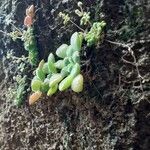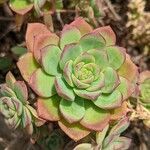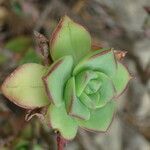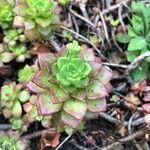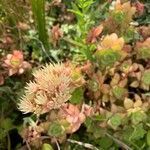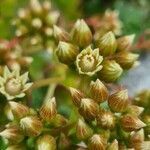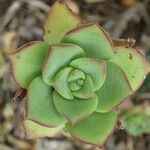Perennial or monocarpic; stems trunk-like, 20-c. 80 cm high, c. 1-2 cm diam., not branched or with few branches, with numerous narrow lf scars. Rosettes terminal, usually 10-18 cm diam., flattened except in summer. Outer rosette lvs to 9-(12) × 3.5 cm, 2-4-(5) mm thick, green, obovate or obovate-spathulate, glabrous on both surfaces, slightly concave on upper, flat on lower; margins ciliate, mostly green, sometimes slightly red towards the mucronate apex. Flowering shoots terminal, either the whole plant or the stem bearing the infl. dying after flowering; axis ± stout, usually tall and erect, glabrous, occasionally glabrate, with leaflike bracts usually present at peak flowering. Infl. a broadly pyramidal panicle, obtuse or rounded to flat at top, on main stem usually 12-20 cm long and almost as wide; fls fairly densely arranged, somewhat secund on branches. Calyx lobes 2.5-4 mm long, glabrous, triangular or triangular-lanceolate. Petals (8)-9-10, 8-11 × c. 2-3 mm, linear, linear-elliptic or linear-lanceolate, greenish white, cream, greenish yellow or pale yellow. Stamens of inner whorl 5.5-9 mm long, the outer whorl usually slightly shorter; stamens and carpels whitish, cream, pale green, greenish yellow, or pale yellow. Scales 0.6-1.5 mm long, almost rectangular or rectangular-cuneate, ± truncate or retuse. Seeds 0.6-0.9 mm long, narrowly obovoid-oblong, minutely longitudinally streaked.
Shrubs closely dome-shaped, 7 dm, with many adventitious woody prop roots. Stems branched, 3-10 mm thick, woody; bark rough-reticulate and fissured. Leaves: rosettes lax, concave, 15-25-leaved, to 1 dm diam.; blade gray-green, often red-edged, obovate, 3-6 cm, 2-5 mm thick, firm, marginal cilia curved forward, broad-based, surfaces glabrous. Cymes lax, flat-topped, 0.5-1.5 dm, glabrous. Flowers bell-shaped, 1 cm diam.; calyx glabrous; petals 7-9, erect, cream. 2n = 72.
